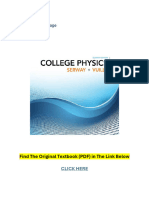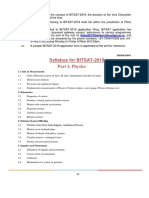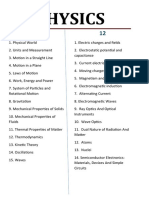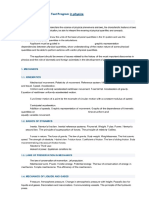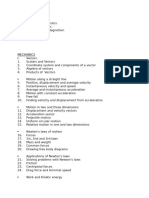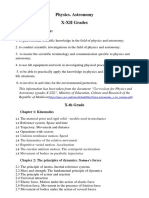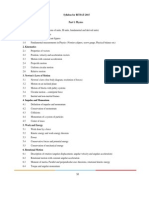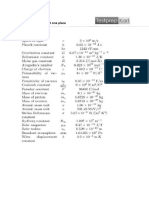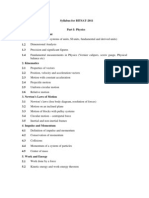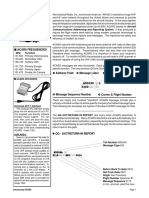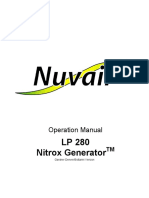Condensed Syllabus Physics
Condensed Syllabus Physics
Uploaded by
Escape VelocityCopyright:
Available Formats
Condensed Syllabus Physics
Condensed Syllabus Physics
Uploaded by
Escape VelocityOriginal Description:
Copyright
Available Formats
Share this document
Did you find this document useful?
Is this content inappropriate?
Copyright:
Available Formats
Condensed Syllabus Physics
Condensed Syllabus Physics
Uploaded by
Escape VelocityCopyright:
Available Formats
A LEVEL: Physics
1. Physical quantities and units 1.1 Physical quantities 1.2 SI Units 1.3 The Avogadro constant 1.4 Scalars and vectors 3. Kinematics 3.1 Linear motion 3.2 Non-linear motion
2. Measurement techniques 2.1 Measurements 2.2 Errors and uncertainties
4. Dynamics 4.1 Newtons laws of motion 4.2 Linear momentum and its conservation 6. Work, energy, power 6.1 Energy conversion and conservation 6.2 Work 6.3 Potential energy, kinetic energy and internal energy 6.4 Power 8. Gravitational field 8.1 Gravitational field 8.2 Force between point masses 8.3 Field of a point mass 8.4 Field near to the surface of the Earth 8.5 Gravitational potential 10. Deformation of solids 10.1 Stress, strain 10.2 Elastic and plastic behaviour
5. Forces 5.1 Types of force 5.2 Equilibrium of forces 5.3 Centre of gravity 5.4 Turning effects of forces
7. Motion in a circle 7.1 Kinematics of uniform circular motion 7.2 Centripetal acceleration 7.3 Centripetal force
9. Phases of matter 9.1 Density 9.2 Solids, liquids, gases 9.3 Pressure in fluids 9.4 Change of phase
11. Ideal gases 11.1 Equation of state 11.2 Kinetic theory of gases 11.3 Pressure of a gas 11.4 Kinetic energy of a molecule 13. Thermal properties of materials 13.1 Specific heat capacity 13.2 Specific latent heat 13.3 Internal energy 13.4 First law of Thermodynamics
12. Temperature 12.1 Thermal equilibrium 12.2 Temperature scales 12.3 Practical Thermometers
14. Oscillations 14.1 Simple harmonic motion 14.2 Energy in simple harmonic motion 14.3 Damped and forced oscillations: resonance 16. Superposition 16.1 Stationary waves 16.2 Diffraction 16.3 Interference 16.4 Two-source interference patterns 16.5 Diffraction grating
15. Waves 15.1 Progressive waves 15.2 Transverse and longitudinal waves 15.3 Polarisation 15.4 Determination of speed, frequency and wavelength 15.5 Electromagnetic Spectrum
17. Electric fields 17.1 Concept of an electric field 17.2 Uniform electric fields 17.3 Force between point charges 17.4 Electric field of a point charge 17.5 Electric potential 19. Current of electricity 19.1 Electric current 19.2 Potential difference 19.3 Resistance and resistivity 19.4 Sources of electromotive force
18. Capacitance 18.1 Capacitors and capacitance 18.2 Energy stored in a Capacitor
20. D.C. circuits 20.1 Practical circuits 20.2 Conservation of charge and energy 20.3 Balanced potentials
21. Magnetic fields 21.1 Concept of magnetic field
22. Electromagnetism 22.1 Force on a current carrying conductor 22.2 Force on a moving charge 22.3 Magnetic fields due to currents 22.4 Force between current-carrying conductors 24. Alternating currents 24.1 Characteristics of alternating currents 24.2 The transformer 24.3 Transmission of electrical energy 24.4 Rectification 26. Quantum physics 26.1 Energy of a photon 26.2 Photoelectric emission of electrons 26.3 Wave-particle duality 26.4 Energy levels in atoms 26.5 Line spectra 28. Direct sensing 28.1 Sensing devices 28.2 The ideal operational amplifier 28.3 Operational amplifier circuits 28.4 Output Devices 30. Communicating information 30.1 Principles of modulation 30.2 Sidebands and bandwidth 30.3 Transmission of information by digital means 30.4 Different channels of communication 30.5 The mobile-phone network
23. Electromagnetic induction 23.1 Laws of electromagnetic induction
25. Charged particles 25.1 Electrons 25.2 Beams of charged Particles
27. Nuclear physics 27.1 The nucleus 27.2 Isotopes 27.3 Nuclear processes 27.4 Mass excess and nuclear binding energy 27.5 Radioactive decay
29. Remote sensing 29.1 Production and use of X-rays 29.2 Production and use of ultrasound 29.3 Use of magnetic resonance as an imaging technique
You might also like
- College Physics 11th Edition PDFDocument22 pagesCollege Physics 11th Edition PDFnawopo2599No ratings yet
- 500usd On Day FACEBOOK PDFDocument47 pages500usd On Day FACEBOOK PDFdragos_a86_200575% (8)
- Dtec-BC (Boost Controller) Instruction ManualDocument24 pagesDtec-BC (Boost Controller) Instruction Manualrawkus2gNo ratings yet
- Novozhilov Yappa Electrodynamics PDFDocument362 pagesNovozhilov Yappa Electrodynamics PDFAscanio Barbosa100% (1)
- Revolver Exploded 2019-01-28Document1 pageRevolver Exploded 2019-01-28naijhabinghiman0% (1)
- The Life-Changing Magic of Tidying Up THDocument3 pagesThe Life-Changing Magic of Tidying Up THCristina Arhip0% (1)
- Content Physics 9702 PDFDocument5 pagesContent Physics 9702 PDFjayeshpNo ratings yet
- Physics SyllabusDocument4 pagesPhysics Syllabusrabin1paswanNo ratings yet
- Bitsat Physics SyllabusDocument3 pagesBitsat Physics SyllabusAmanNo ratings yet
- Important Topics Phy - 12Document3 pagesImportant Topics Phy - 12NO NAME xOPNo ratings yet
- Syllabus For BITSAT-2023: Part I: PhysicsDocument11 pagesSyllabus For BITSAT-2023: Part I: Physicsjake nallaNo ratings yet
- Syllabus For BITSAT-2019 Part I: Physics: AnnexureDocument12 pagesSyllabus For BITSAT-2019 Part I: Physics: AnnexureSunit JalanNo ratings yet
- INDEX - The Feynman Lectures On PhysicsDocument5 pagesINDEX - The Feynman Lectures On PhysicsJuanLoredoNo ratings yet
- Physics Notes-Qrect Format-Video Version-2014Document64 pagesPhysics Notes-Qrect Format-Video Version-2014bens082023No ratings yet
- BITSAT 2024 SyllabusDocument13 pagesBITSAT 2024 Syllabusdineshramani1975No ratings yet
- Dasar Latihan Minima 2010Document4 pagesDasar Latihan Minima 2010Punitha MarimuthooNo ratings yet
- Remedial CourseOutlineDocument2 pagesRemedial CourseOutlineefokimemNo ratings yet
- Electromagnetism: Maxwell Equations, Wave Propagation and EmissionFrom EverandElectromagnetism: Maxwell Equations, Wave Propagation and EmissionRating: 4.5 out of 5 stars4.5/5 (18)
- Syllabus For BITSAT-2019 Part I: Physics: AnnexureDocument12 pagesSyllabus For BITSAT-2019 Part I: Physics: AnnexureSaurabh YadavNo ratings yet
- ChemistryDocument1 pageChemistrySohon SenNo ratings yet
- Introduction To Electrodynamics: David J. Griffiths Reed CollegeDocument7 pagesIntroduction To Electrodynamics: David J. Griffiths Reed CollegeMustafa Alper SelverNo ratings yet
- Questions of Exam 604Document2 pagesQuestions of Exam 604rashida mammadovaNo ratings yet
- Jamb Physics SyllabusDocument2 pagesJamb Physics SyllabusDami Lare100% (1)
- Units & MeasurementDocument12 pagesUnits & MeasurementPranjal GuptaNo ratings yet
- Physics' Contents, AlonsoDocument10 pagesPhysics' Contents, AlonsootavioholandaNo ratings yet
- Birla Institute of Technology and ScienceDocument4 pagesBirla Institute of Technology and ScienceBiswajit RoyNo ratings yet
- Tamm Fundamentals of The Theory of ElectricityDocument695 pagesTamm Fundamentals of The Theory of ElectricityEvaldas StankeviciusNo ratings yet
- Relativity An Introduction To Special and General RelativityDocument418 pagesRelativity An Introduction To Special and General RelativitySoham Pal100% (19)
- Chris Millar: George Bennet™Document268 pagesChris Millar: George Bennet™Ray PughNo ratings yet
- Tools of Radio AstronomyDocument8 pagesTools of Radio AstronomyKiran KumarNo ratings yet
- BITSAT 2011 SyllabusDocument19 pagesBITSAT 2011 SyllabusFarheen SayedNo ratings yet
- Entrance Test Program in Physics Entrance Test Program in PhysicsDocument4 pagesEntrance Test Program in Physics Entrance Test Program in PhysicsAisy MaffazNo ratings yet
- Physics Objective Learning.Document4 pagesPhysics Objective Learning.badioonhyirae87No ratings yet
- Índice: Chapter 1: Understanding The Physical UniverseDocument8 pagesÍndice: Chapter 1: Understanding The Physical UniverseRobis OliveiraNo ratings yet
- Syllabus For BITSAT-2017 Part I: Physics: AnnexureDocument15 pagesSyllabus For BITSAT-2017 Part I: Physics: AnnexureknlsinhaNo ratings yet
- Syllabus For BITSATDocument10 pagesSyllabus For BITSATNilesh PatilNo ratings yet
- Chapter 1: Electric Charges and FieldsDocument6 pagesChapter 1: Electric Charges and FieldsNasla AbdulsalamNo ratings yet
- 02 Physics PDFDocument6 pages02 Physics PDFSivakumar BandlaNo ratings yet
- Physics AstronomyDocument20 pagesPhysics AstronomyCristian HaretNo ratings yet
- PHYSICS Formula Book Final Copy-1Document27 pagesPHYSICS Formula Book Final Copy-1Jeswin PaulNo ratings yet
- Syllabus Followed at Massey UniversityDocument17 pagesSyllabus Followed at Massey Universityjhon jackNo ratings yet
- Problems For PH1016: Chapter 31: 37, 41, 43, 45 (Op.), 57, 59, 61 (Op.) Chapter 32. 35 (Op.), 37, 39, 45, 47, 49, 51Document9 pagesProblems For PH1016: Chapter 31: 37, 41, 43, 45 (Op.), 57, 59, 61 (Op.) Chapter 32. 35 (Op.), 37, 39, 45, 47, 49, 51Vũ Đức TuânNo ratings yet
- Part I: Physics 1. Units & MeasurementDocument13 pagesPart I: Physics 1. Units & MeasurementKaamNo ratings yet
- Bitsat2015 BrochureDocument12 pagesBitsat2015 BrochureSaxicolineOverworkNo ratings yet
- (Physics and Its Applications) E. R. Dobbs (Auth.) - Basic Electromagnetism-Springer Netherlands (1993)Document261 pages(Physics and Its Applications) E. R. Dobbs (Auth.) - Basic Electromagnetism-Springer Netherlands (1993)Fahdila Rahma100% (1)
- Fundamentals of ElectrochemistryDocument5 pagesFundamentals of Electrochemistryapi-3723333100% (1)
- I V Savelyev Physics General Course Vol 2 PDFDocument509 pagesI V Savelyev Physics General Course Vol 2 PDFeloihy100% (3)
- Ts Eapcet Phy Formula BookDocument31 pagesTs Eapcet Phy Formula BookK.Harshith SubrahmanyamNo ratings yet
- BITSAT Syllabus: Part I: PhysicsDocument14 pagesBITSAT Syllabus: Part I: Physicsrajasahab753No ratings yet
- Bits at SyllabusDocument15 pagesBits at SyllabusCharith ReddyNo ratings yet
- Elementary Textbook On Physics Volume 2 Electricity and Magnetism PDFDocument458 pagesElementary Textbook On Physics Volume 2 Electricity and Magnetism PDFAnna Watson100% (2)
- Physics ReviewersDocument1 pagePhysics ReviewersDanielle BarkerNo ratings yet
- 12th Physics METS 2024Document5 pages12th Physics METS 2024Raheela NaveedNo ratings yet
- Paper PhyDocument301 pagesPaper PhyMuhammadNaveedNo ratings yet
- Important Questions For DerivationDocument3 pagesImportant Questions For DerivationraajeevmageshNo ratings yet
- Table of Contents Nelson Physics 12Document5 pagesTable of Contents Nelson Physics 12i. g.50% (2)
- Instant Download Condensed Phase Molecular Spectroscopy and Photophysics 2nd Edition Anne Myers Kelley PDF All ChapterDocument49 pagesInstant Download Condensed Phase Molecular Spectroscopy and Photophysics 2nd Edition Anne Myers Kelley PDF All Chapteraouinablauer100% (4)
- Novozhilov Yappa ElectrodynamicsDocument362 pagesNovozhilov Yappa ElectrodynamicsRamakrishna Sharma Potlandurthy100% (3)
- Magnetic Resonance Imaging: Physical Principles and Sequence DesignFrom EverandMagnetic Resonance Imaging: Physical Principles and Sequence DesignRating: 3 out of 5 stars3/5 (1)
- Conversations on Electric and Magnetic Fields in the CosmosFrom EverandConversations on Electric and Magnetic Fields in the CosmosNo ratings yet
- Video 1 of 4 of Pre-Flashover - A Few Plume ModelsDocument18 pagesVideo 1 of 4 of Pre-Flashover - A Few Plume ModelsEscape VelocityNo ratings yet
- Video 1 (Of 4) Introduction To Postflashover FireDocument11 pagesVideo 1 (Of 4) Introduction To Postflashover FireEscape VelocityNo ratings yet
- Acs Chemmater 6b00348Document13 pagesAcs Chemmater 6b00348Escape VelocityNo ratings yet
- Baillie Gifford Values PDFDocument16 pagesBaillie Gifford Values PDFEscape VelocityNo ratings yet
- Transport Phenomena - 1 CHEN 10031 1 Year Chem Eng & Pet Eng Renold Building C16Document26 pagesTransport Phenomena - 1 CHEN 10031 1 Year Chem Eng & Pet Eng Renold Building C16Escape VelocityNo ratings yet
- Math Flyer 2Document2 pagesMath Flyer 2Escape VelocityNo ratings yet
- Under 18 Agreement NewcastleDocument2 pagesUnder 18 Agreement NewcastleEscape VelocityNo ratings yet
- Coffee Table Book - Naya RaipurDocument19 pagesCoffee Table Book - Naya RaipurAmitomSudarshanNo ratings yet
- Yaskawa A1000Document354 pagesYaskawa A1000NICOELECTRONICO100% (1)
- Ding-Dong Bell PDFDocument1 pageDing-Dong Bell PDFShrivlsi RamNo ratings yet
- TM20 - Economic and Product Design Considerations in Machining PDFDocument35 pagesTM20 - Economic and Product Design Considerations in Machining PDFAlessio NotariNo ratings yet
- Paceman Verbal Critique TemplateDocument2 pagesPaceman Verbal Critique TemplateZulfadli Haron100% (1)
- Experiment No. Compaction Test: (Moisture - Unit Weight Relationships)Document4 pagesExperiment No. Compaction Test: (Moisture - Unit Weight Relationships)Opu DebnathNo ratings yet
- Acars PDFDocument4 pagesAcars PDFAnta Masimmo100% (1)
- Piping Hydrotest Procedure - Oil - Gas - WorldDocument3 pagesPiping Hydrotest Procedure - Oil - Gas - WorldFrank100% (6)
- 03 - PointerDocument21 pages03 - PointerrakhaaditNo ratings yet
- TWW Arcade Cabinet V2 MetricDocument13 pagesTWW Arcade Cabinet V2 MetricDemos StratigopoulosNo ratings yet
- NIBM ProspectusDocument22 pagesNIBM Prospectushasanth_maihoonaa4854No ratings yet
- Trelleborg Seal GuideDocument308 pagesTrelleborg Seal Guidechez ezNo ratings yet
- PUMPS Part 2Document11 pagesPUMPS Part 2Kaiser CarloNo ratings yet
- Introduction From Brewing Science, Technology and Print, 1700-1880Document10 pagesIntroduction From Brewing Science, Technology and Print, 1700-1880Pickering and ChattoNo ratings yet
- Talend Data Quality GuideDocument45 pagesTalend Data Quality GuideLuis GallegosNo ratings yet
- Reflections On Managing WaterDocument282 pagesReflections On Managing WaterBalipara FoundationNo ratings yet
- 2017 Minnesota State Fair Color MapDocument2 pages2017 Minnesota State Fair Color MapGoMNNo ratings yet
- Lecture 5Document9 pagesLecture 5shivani lohia100% (1)
- Solar 3G Internet Repeater: GuideDocument43 pagesSolar 3G Internet Repeater: GuideXanderGuerin100% (2)
- Sbac Tech Skills ChecklistDocument4 pagesSbac Tech Skills Checklistapi-270449963No ratings yet
- Graphical Password DocumentationDocument41 pagesGraphical Password Documentationsrihitha nimmala100% (2)
- LP 280 Nitrox Generator: Operation ManualDocument44 pagesLP 280 Nitrox Generator: Operation ManualJhon Marquez MárquezNo ratings yet
- CS Candy BWTS Manual PB-05889 - v0 PDFDocument658 pagesCS Candy BWTS Manual PB-05889 - v0 PDFNikul PanchalNo ratings yet
- 808 Recomendation On Performance Standards For Public Address Systems On Passenger Ships Including CDocument6 pages808 Recomendation On Performance Standards For Public Address Systems On Passenger Ships Including CTefin TefinNo ratings yet
- ARM ProcessDocument2 pagesARM ProcessVeena Divya KrishnappaNo ratings yet
